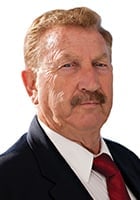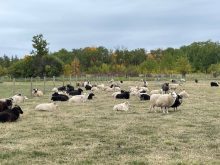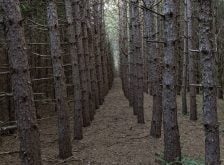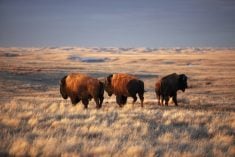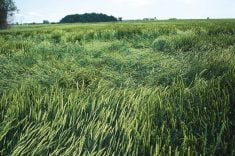I was offered the position of provincial plant pathologist for Alberta Agriculture by Joe Gurba, head of the crop protection branch, in August 1974. I was at the time an assistant professor at the University of Guelph, more interested in rugby coaching than in basic plant disease research. Joe told me the provincewide position would be primarily diseases of field crops, with some input on horticultural problems.
Joseph Gurba had become famous in Alberta by then, and even worldwide, for his provincial rat control program in the 1950s and ’60s.
The Norway rat (Rattus norvegicus), a notorious carrier of fatal human diseases, causes hundreds of billions of dollars damage annually, worldwide. The rats inhabit sewers, garbage dumps and, on the Prairies in particular, farm buildings and grain elevators. They spoil countless millions of dollars of farm-stored grain every year with feces and urine. They tunnel into buildings and chew their wiring, leading to fires. And their reproductive rate is truly phenomenal: just one female rat’s descendants can result in over 10,000 rats in just three years or so, even in our Prairie climate.
Read Also

Gentle treatments for pain in the neck
Heading toward year-end, people unknowingly tense up against the cold and busyness, causing neck pain that can often be treated with appropriate support and gentle mobility, athletic therapist Kathlyn Hossack says.

Joe took charge of Alberta’s rat program, with five or so staff, in the 1950s. Within a few years, with lots of effort, it eliminated the rat infestations in the province. Thereafter, paid personnel would continually patrol the Saskatchewan and Montana borders for any rat infestations, as the forests to Alberta’s north and the mountains to its west were natural rat barriers. Both Saskatchewan and Manitoba were encouraged to join the program over the years, but never did so.
Joe Gurba was a dedicated individual who had an excellent sense of agricultural direction. Joe was the founding force behind the western committees on plant disease and pest management that provide annual exchanges of expert analysis and research ideas between the four western provinces.
Joe was also the individual who encouraged me and others to keep the province’s one million elms free of Dutch elm disease. He was also one of the early movers behind the very successful control programs against blackleg of canola, bacterial ring rot of potatoes and fusarium head blight of cereals — concepts which, when implemented, saved Prairie farmers not millions but many billions of dollars over the past 50 years.
Joe Gurba also strongly opposed the import of wild boar farming into the Prairies, stating that if they ever got loose, they could be a real problem. He said “nonsense” to the argument of our climate being too cold, since wild boar were native to Siberia.
In a poll in the province’s centennial year to name the 50 greatest Albertans, Joe Gurba placed sixth, behind Emily Murphy and Ralph Klein and ahead of notables such as Ernest Manning, Wayne Gretzky, Stockwell Day, Joe Clark and Kurt Browning — an amazing feat for an agricultural specialist of modest demeanour. Joseph B. Gurba was inducted into the Alberta Agriculture Hall of Fame in 1992.

What caught my attention to write up the Joe Gurba story was an unpublished paper he wrote in 2002 for a Ukrainian Association meeting, titled From Peasant Farmer to Master Farmer: The Impact of Ukrainian Agrologists on the Transformation of Agriculture in Rural East-Central Alberta. This write-up outlined the first Ukrainians to farm in the 1890s at Gretna in southern Manitoba, before they brought their families to homestead in Alberta. These first Ukrainians would return to their home regions to encourage friends and relatives to move to Canada. By 1900 many Ukrainian families settled in the Vegreville area, where they co-operated with German, Scandinavian and French settlers to upgrade their homesteads. These Ukrainian immigrants were encouraged by the Canadian and British governments to bring their tools to organize and build their free homesteads. In their own country, the Ukrainians had been part of the Austro-Hungarian Empire, in which they were treated badly and were little more than slave labour.
There was a very rapid buildup of Ukrainian immigrants to the Canadian Prairies before the First World War and right afterward, resulting in some 225,000 Ukrainian immigrants in central Alberta settling in some 70 or so townships. Alberta Agriculture developed an unofficial policy to cater to larger ethnic communities by employing French- and Ukrainian-speaking bilingual district agriculturalists (DAs).
Joe attributed his employment as one of those DAs to that policy, following his graduation in 1950 with a B.Sc. as part of a class of some 125 University of Alberta ag graduates. Soon many of the DAs were of Ukrainian origin, all raised on farms on Alberta parkland.
During the 1940s the number of successful Ukrainian farmers increased dramatically and very many Ukrainians became civil servants and regional and county employees. By the late 1950s there were significant numbers of outstanding Ukrainian scientists and agricultural specialists in Alberta.

So rapid was the Ukrainian immigration to Canada that it became one of the largest Ukrainian diasporas in the world. Ukrainian immigration started in 1896, as the Canadian and British governments promoted the Prairies as the “Last Best West.” By 1931, Ukrainian Canadians comprised 2.2 per cent of Canada’s population. Today there are roughly 1.4 million Ukrainian Canadians. Alberta has the largest number, at 345,000 or eight per cent of the province’s population. Manitoba has 165,000, who make up almost 20 per cent of the province’s population. About 60 per cent of Ukrainian Canadians live in Prairie Canada and make up around 11 per cent of the farming population.
I recall how, because of my frequent travels back and forth across the Prairies, I was impressed by the very many Ukrainian churches. Most were either Greek Orthodox or Ukrainian Catholic but also a mixture of other denominations. Along with the ever-present grain elevators, the churches were like beacons across the flat Prairies.
Joe Gurba passed away on Feb. 25, 2009, at the age of 86.
In December of 1991, with an 84 per cent referendum turnout, 90 per cent of Ukrainians cast their votes to declare independence from the then-U.S.S.R.

